高一英语外研版必修1module1and3说课稿
- 格式:doc
- 大小:16.50 KB
- 文档页数:2
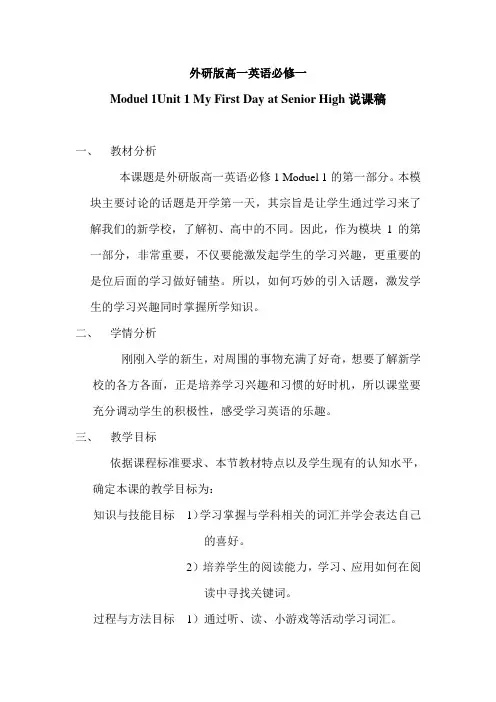
外研版高一英语必修一Moduel 1Unit 1 My First Day at Senior High说课稿一、教材分析本课题是外研版高一英语必修1 Moduel 1的第一部分。
本模块主要讨论的话题是开学第一天,其宗旨是让学生通过学习来了解我们的新学校,了解初、高中的不同。
因此,作为模块1的第一部分,非常重要,不仅要能激发起学生的学习兴趣,更重要的是位后面的学习做好铺垫。
所以,如何巧妙的引入话题,激发学生的学习兴趣同时掌握所学知识。
二、学情分析刚刚入学的新生,对周围的事物充满了好奇,想要了解新学校的各方各面,正是培养学习兴趣和习惯的好时机,所以课堂要充分调动学生的积极性,感受学习英语的乐趣。
三、教学目标依据课程标准要求、本节教材特点以及学生现有的认知水平,确定本课的教学目标为:知识与技能目标1)学习掌握与学科相关的词汇并学会表达自己的喜好。
2)培养学生的阅读能力,学习、应用如何在阅读中寻找关键词。
过程与方法目标1)通过听、读、小游戏等活动学习词汇。
2)小组活动完成对课文的分析。
情感态度与价值观目标通过这一课的学习,激发学习的积极性,克服部分同学学英语的畏难心理,为今后的学习打下好的基础。
教学重点、难点依据课程标准要求和本节教材实际,并结合学生的实际,本节课一是要兴趣为主,二是开始学习阅读方法。
由于初中对阅读方法的涉及不是很多,这一方面可能是刚开始接触,所以一定要把握好难易程度,这是本课的难点。
四、教学方法由身边的事物开始,通过游戏的方式让每个学生参与进来,有话可说,培养学习兴趣和主动性。
由分组讨论,激发动机,培养学生的学习积极性。
五、教学过程导入:In your new school, you must see many new things. Please find out some new things in our classroom……Introduction: 1)Say the names of your textbooks.2)Game: work in pairs. Do 1) again as quickly as youcan.3)Group your textbooks.4)Ask some students write their answers on theblackboard.5)Game.Reading:1)略读,找出各段大意。
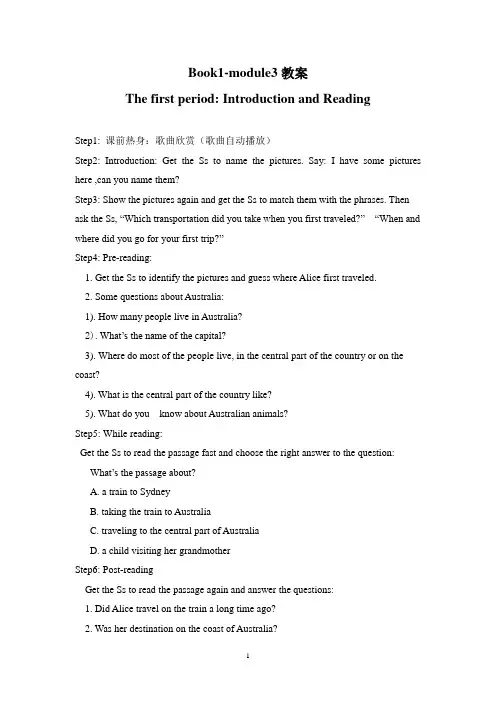
Book1-module3教案The first period: Introduction and ReadingStep1: 课前热身:歌曲欣赏(歌曲自动播放)Step2: Introduction: Get the Ss to name the pictures. Say: I have some pictures here ,can you name them?Step3: Show the pictures again and get the Ss to match them with the phrases. Then ask the Ss, “Which transportation did you take when you first traveled?”“When and where did you go for your first trip?”Step4: Pre-reading:1. Get the Ss to identify the pictures and guess where Alice first traveled.2. Some questions about Australia:1). How many people live in Australia?2). What’s the name of the capital?3). Where do most of the people live, in the central part of the country or on the coast?4). What is the central part of the country like?5). What do you know about Australian animals?Step5: While reading:Get the Ss to read the passage fast and choose the right answer to the question:What’s the passage about?A. a train to SydneyB. taking the train to AustraliaC. traveling to the central part of AustraliaD. a child visiting her grandmotherStep6: Post-readingGet the Ss to read the passage again and answer the questions:1. Did Alice travel on the train a long time ago?2. Was her destination on the coast of Australia?3.Was the scenery the same during the whole journey?4.Did she study while she was on the train?5. What Did the Australians use to travel to the central part of the country?6. Do they still use camels to deliver goods?Step7: Homework: SummaryGive a summary about Alice’s first ride using the questions and answers in step6 as a guide.e.g.Recently Alice first traveled on a train to Alice Spring , in the center of Australia. The scenery of the whole journey was colorful. At first there were fields, then it was desert.While she was on the train, she studied Chinese.A long time ago, Australians tried using horses to travel to the central part of the country. But later they used camels. Now they use the train called Ghan to travel.。
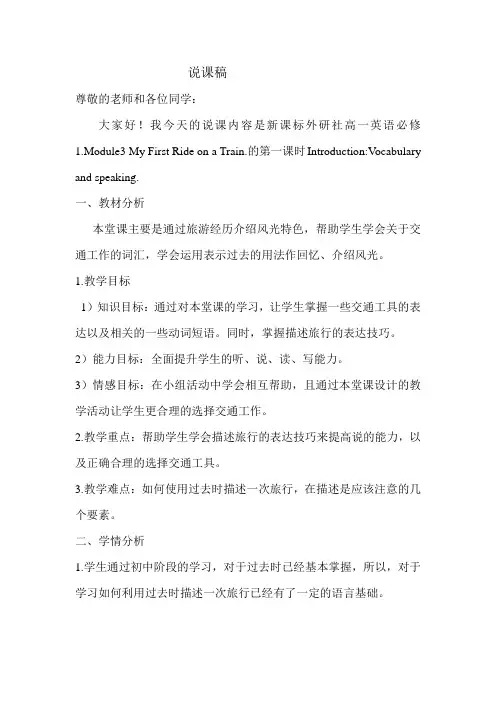
说课稿尊敬的老师和各位同学:大家好!我今天的说课内容是新课标外研社高一英语必修1.Module3 My First Ride on a Train.的第一课时Introduction:V ocabulary and speaking.一、教材分析本堂课主要是通过旅游经历介绍风光特色,帮助学生学会关于交通工作的词汇,学会运用表示过去的用法作回忆、介绍风光。
1.教学目标1)知识目标:通过对本堂课的学习,让学生掌握一些交通工具的表达以及相关的一些动词短语。
同时,掌握描述旅行的表达技巧。
2)能力目标:全面提升学生的听、说、读、写能力。
3)情感目标:在小组活动中学会相互帮助,且通过本堂课设计的教学活动让学生更合理的选择交通工作。
2.教学重点:帮助学生学会描述旅行的表达技巧来提高说的能力,以及正确合理的选择交通工具。
3.教学难点:如何使用过去时描述一次旅行,在描述是应该注意的几个要素。
二、学情分析1.学生通过初中阶段的学习,对于过去时已经基本掌握,所以,对于学习如何利用过去时描述一次旅行已经有了一定的语言基础。
2.在英语语言方面,学生有了一定的听、说、读、写基础,但是,还需要进一步的提高,尤其是在描述第一次旅行的技能方面和词汇方面需要进一步学习。
三、教学方法根据高中英语课程标准以及对教材和学生情况分析,我将在本堂课的教学中运用任务型教学方法,开展自主性学习的小组活动,使合作式学习、探究式学习与独立思考相结合,最大程度的提高课堂学习效率。
四、课堂程序设计本堂课的教学活动主要有以下几个方面:1.通过P21活动1,利用图片展示交通工具,使学生学习有关交通工具的词汇,同时给学生创设一种愉快、轻松、积极的学习氛围。
2.通过P21活动2和活动3,进一步加强对交通工具的有关词汇以及相关的动词词汇的学习。
3.通过教师自己创设的选乘交通工具的模拟情况,让学生做出合理的判断。
4.通过P21活动4,让学生讲述自己的第一次旅行。
1)教师先自己讲述自己的第一次旅行做示范,然后让学生猜测该老师当时的感受,为后面的speaking部分做铺垫。
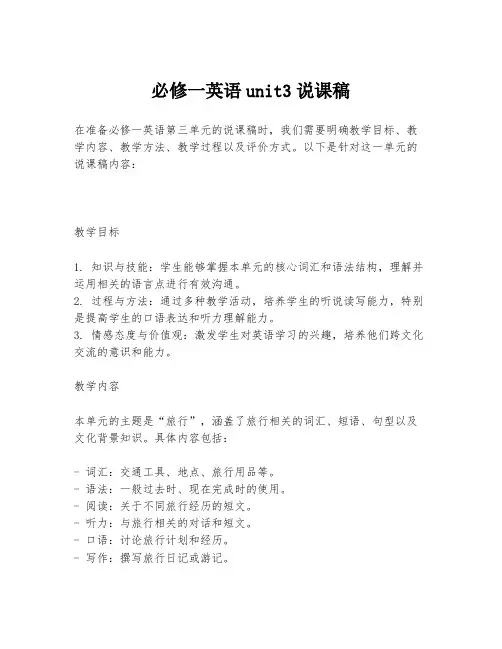
必修一英语unit3说课稿在准备必修一英语第三单元的说课稿时,我们需要明确教学目标、教学内容、教学方法、教学过程以及评价方式。
以下是针对这一单元的说课稿内容:教学目标1. 知识与技能:学生能够掌握本单元的核心词汇和语法结构,理解并运用相关的语言点进行有效沟通。
2. 过程与方法:通过多种教学活动,培养学生的听说读写能力,特别是提高学生的口语表达和听力理解能力。
3. 情感态度与价值观:激发学生对英语学习的兴趣,培养他们跨文化交流的意识和能力。
教学内容本单元的主题是“旅行”,涵盖了旅行相关的词汇、短语、句型以及文化背景知识。
具体内容包括:- 词汇:交通工具、地点、旅行用品等。
- 语法:一般过去时、现在完成时的使用。
- 阅读:关于不同旅行经历的短文。
- 听力:与旅行相关的对话和短文。
- 口语:讨论旅行计划和经历。
- 写作:撰写旅行日记或游记。
教学方法1. 任务型教学法:通过设计旅行计划、分享旅行经历等任务,让学生在实际语境中运用语言。
2. 合作学习:小组合作完成项目,促进学生之间的交流与合作。
3. 多媒体教学:利用图片、视频等多媒体材料,增强学习的趣味性和直观性。
教学过程1. 导入(Lead-in):通过展示世界各地的图片或视频,激发学生对旅行的兴趣,引入本单元主题。
2. 新课呈现(Presentation):教授新词汇和语法结构,通过例句和情景对话让学生理解其用法。
3. 练习(Practice):通过填空、转换句型、角色扮演等活动,巩固学生对新知识的掌握。
4. 应用(Application):设计小组讨论、模拟旅行计划等活动,让学生将所学知识运用到实际情境中。
5. 总结(Summary):回顾本单元的重点内容,鼓励学生进行自我反思。
6. 作业(Homework):布置相关的写作或口语作业,如写一篇旅行日记或准备一个关于旅行的口头报告。
评价方式1. 形成性评价:通过课堂表现、小组活动和口头报告等方式,持续跟踪学生的学习进展。
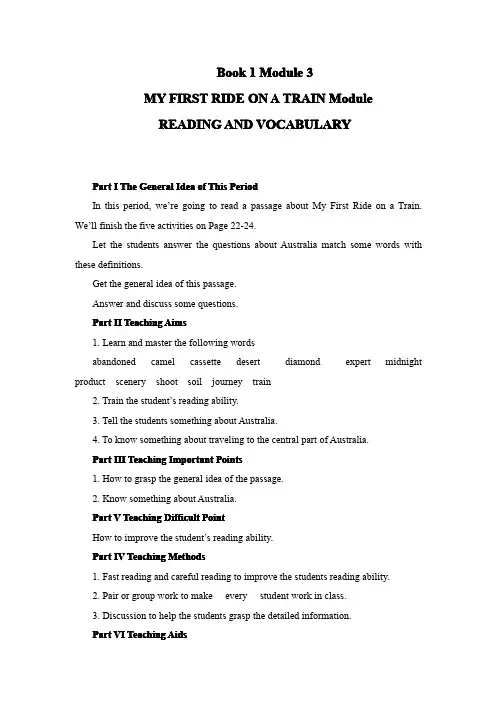
Book1Module3MY FIRST RIDE ON A TRAIN ModuleREADING AND VOCABULARYPeriodPart I The General Idea of This PeriodIn this period,we’re going to read a passage about My First Ride on a Train. We’ll finish the five activities on Page22-24.Let the students answer the questions about Australia match some words with these definitions.Get the general idea of this passage.Answer and discuss some questions.Part II Teaching AimsAims1.Learn and master the following wordsabandoned camel cassette desert diamond expert midnight product scenery shoot soil journey train2.Train the student’s reading ability.3.Tell the students something about Australia.4.To know something about traveling to the central part of Australia.PointsPart III Teaching Important Points1.How to grasp the general idea of the passage.2.Know something about Australia.PointPart V Teaching Difficult PointHow to improve the student’s reading ability.MethodsPart IV Teaching Methods1.Fast reading and careful reading to improve the students reading ability.2.Pair or group work to make every student work in class.3.Discussion to help the students grasp the detailed information.AidsPart VI Teaching Aids1.a computer2.a projector3.the blackboardProceduresPart VII Teaching ProceduresStep1GreetingT:Good morning!S:Good morning,teacher!T:Sit down,please!Step2Lead-inT:The weather in September is very nice.It’s the best time to travel.Do you like travel?Ss:Yes.T:Have you ever been to Australia?Ss:No.T:Today let’s learn something about Australia.Step3Presentation(Show picture of a Kangaroo on the screen.)T:What do you call it?Ss:A Kangaroo.T:Where does it live?Do you know?S:In Australia,of course.T:Open your books at Page22,let’s come to Australia.T:Do you know the name of the capital city?S:Canberra.T:Do you know how many people live there?S:About20million.T:What do you think the central part of the country is like?S:Desert.T:Where do you think most of the people live,in the central part of the country or on the coast?S:On the east/southeast coast.T:What Australian animals do you know about?S:Koala bear,Kangaroo,Duck billed platypus,echidna and dingo(澳洲野犬).T:Yes,very good,thanks a lot,some of these animals are marsupials,that is,the mother keeps the baby in a pouch on her stomach.T:Now,you’ve known much about Australia.Step4Learning to Read(Show a passage on the screen.)T:Well,let’s look at the screen.Read through the passage,you’ll learn something more about Australia.Culture Box:AustraliaAustralia is7686850square km,with25760km of coastline.It is the6th largest country in the world,but has a relatively small population,because much of the central and western part of the country is uninhabitable,being desert.There are19 731984people(July2003estimate)living there.Of these,6.2million live in New South Wales,and3789000 live in Sydney,3.3million in Melbourne,1.5million in Brisbane,and only313000in the Capital,Canberra.85%of the population occupy1% of the land!There are386049aborigines living there,they are the indigenous people of Australia.The climate is variable.The center and west is arid desert and semi desert,the south and east is temperate and the north is tropical.The lowest point is Lake Eyre(15 m below sea level)and the highest point is Mount Kosciusko(2229m above sea level).6.86%of the land in arable.The country is divided into6states(New South Wales,Queensland,South Australia,Tasmania,Victoria,Western Australia)and2territories(Australian Capital Territory,Northern Territory).Step5Word StudyT:Before we read the passage,my first ride on the train,check the meaning of these words.(Show them on the screen.)abandoned adj .被遗弃的,camels,cassette,clouds,colorful,desert,diamonds,distance,experts,famous,farms,fields,food,products,recently,sand,scenery,shine,shoot,soil,supply,weather1.Read through the words as the students follow,make sure the students understand the words.2.Pay attention to the correct pronunciation of them.3.Tick the words you will see in the passage.4.(Brainstorm)get the students to match some of the words with these definitions quickly.(1)First ask them to do the activity individually then check the answers.(2)Call back the answers from the class.Suggested answers:①desert②diamonds③passengers ④sand⑤clouds⑥soil (field)/farms(3)Go through the“learning to learn box”with the students.Step6Fast-readingT:Open your books at Page23and listen to the tape carefully.1.Play the tape for the students to listen for the first time,and tell the students to catch the main idea of the passage“My First Ride on a Train”.2.Read through the topics as the students follow.3.Ask students to do the activity individually,then check with the other students.Suggested answers:The passage is about traveling to the central part of Australia.Step7Careful-readingGet the students to read by themselves carefully then give some questions to answer.(Show the question on the screen.)Q1:Did Alice travel on the train a long time ago?Q2:Was her destination on the coast of Australia?Q3:Was the scenery the same during the whole journey?Q4:Did she study while she was on the train?Q5:Did the Australians use horses to travel to the centralpart of the country?Q6:Do they still use camels to deliver goods?1.Read through the questions and make sure that the students understand them.2.Ask students to do the activity individually,then check the answers with the students.Suggested answers:1.No,she traveled on the train recently.2.No,Alice travelled in the centre of Australia.3.No,at first there were fields,then it was desert.4.Yes,she studied Chinese.5.Yes,at first,but the horses didn’t like the hot weather.6.No,they use the train now.Step8Discussion1.Put the students into groups of four to discuss the question.Q1:What sort of people do you think travel on the Ghan train?Fill in the form(If the train can hold40people).What sort of people Number ofpeopleWhy do you think they will be onthe Ghan train?Young students 5They are having a holiday.They like traveling on the train.Chinese10They want to see Australia.They are in a group.Q2:What kind of towns and villages do you think the train passed?(Show some pictures of the cities,rural villages in Australia.)First find out cities,such as Sydney,Alice Springs,then let Ss describe the route of the train movements.(to the west,turn north,to the east)2.Call back answers from the class.Students’own answers are various.Additional topicTeacher give the tips for traveling abroad,whether you are traveling overseas for business,pleasure or study,the best way to ensure a carefree and relaxing trip is to prevent problems before they happen.The more you learn about passports,visas, customs,and other travel basics,the less likely you are to have difficulties during your travels.Let the students think after class:1.What will you prepare before you go?2.While you are on the way,how to deal with the unexpected?3.Safety tips given while you are on the way?Step9Summary and HomeworkToday we have learned something more about“My First ride on the Train”,we have known something about it,now homework for today.1.Read the passage again and again.2.Find out the phrases of the passage.Step10The Design of Writing on the BlackboardUnit3My First Ride on a TrainThe Second PeriodReading and vocabularyQuestions Answers WordsabandonedexpertStep11Activity and InquirySteps Students’Acting Teacher’s Organizing1Look at the screen.Show the following questions. 2Look at the picture.Give the guidance.A list of animals.。
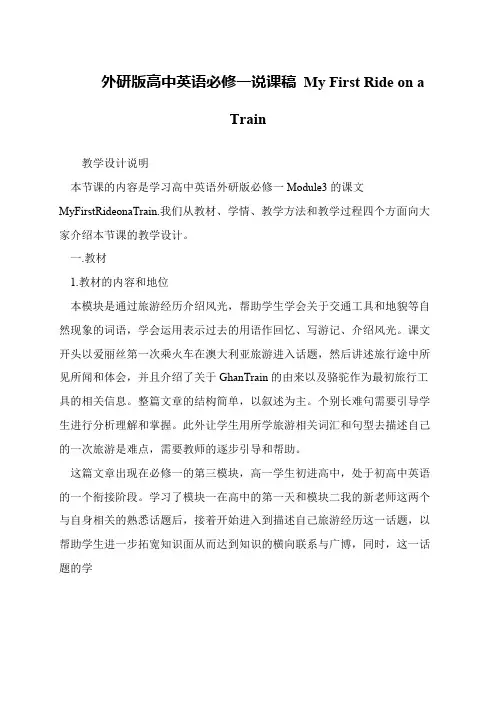
外研版高中英语必修一说课稿My First Ride on a
Train
教学设计说明
本节课的内容是学习高中英语外研版必修一Module3的课文MyFirstRideonaTrain.我们从教材、学情、教学方法和教学过程四个方面向大家介绍本节课的教学设计。
一.教材
1.教材的内容和地位
本模块是通过旅游经历介绍风光,帮助学生学会关于交通工具和地貌等自然现象的词语,学会运用表示过去的用语作回忆、写游记、介绍风光。
课文开头以爱丽丝第一次乘火车在澳大利亚旅游进入话题,然后讲述旅行途中所见所闻和体会,并且介绍了关于GhanTrain的由来以及骆驼作为最初旅行工具的相关信息。
整篇文章的结构简单,以叙述为主。
个别长难句需要引导学生进行分析理解和掌握。
此外让学生用所学旅游相关词汇和句型去描述自己的一次旅游是难点,需要教师的逐步引导和帮助。
这篇文章出现在必修一的第三模块,高一学生初进高中,处于初高中英语的一个衔接阶段。
学习了模块一在高中的第一天和模块二我的新老师这两个与自身相关的熟悉话题后,接着开始进入到描述自己旅游经历这一话题,以帮助学生进一步拓宽知识面从而达到知识的横向联系与广博,同时,这一话题的学。
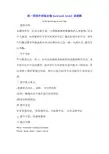
高一英语外研版必修book1and book2 说课稿B1 M1 My first day at senior high一教材内容本模块介绍一位高中新生第一天到校观察和接触到的人和事物,以及个人感受,内容紧密结合学生的现实生活,通过此部分的学习,使学生们通过课本所描述的生活对比感知自己高一第一天的生活,激发学习兴趣。
二学生分析学生刚进入高一学习,还不适应新的老师新的环境新的教学方法,更不适应高中全英语教学,很多学生存在胆怯害羞不敢开口的情况,所以老师上课时要通过问候,师生自我介绍等方式消除学生的害怕心理。
三教学重点难点1掌握重点词汇|、词组、及句型结构2比较一般现在时与现在进行时的用法3描述学校的情况四教学方法任务型教学法、情景教学法、交际教学法、启发式教学法五教学手段:多媒体教学六教学步骤Period 1 Introduction +listening +vocabularyPictures –words---listen1----listen2---act out更新时间:2012-05-19 20:36:00说课稿各位老师大家好,今天我说课的内容为外研社普通高中课程标准实验教学用书必修1,module3 My first ride on a train。
我上的是一堂听说课。
一教材分析::1.新教材特点介绍:高中必修阶段教材模块内容分为,Introduction, Reading and Vocabulary, Listening, Speaking, Writing, Grammar, Function, Everyday English, Pronunciation, Culture Corner, Task and Module File, 听说读写,词汇,语法等基本成对出线,各项技能均为综合性训练,注重语境化和语用化。
从模块内容上看,第一增加了Function, Everyday English 和 Pronunciation,这三部分是与模块听力或阅读材料有关的常见和典型的英语习惯用语。
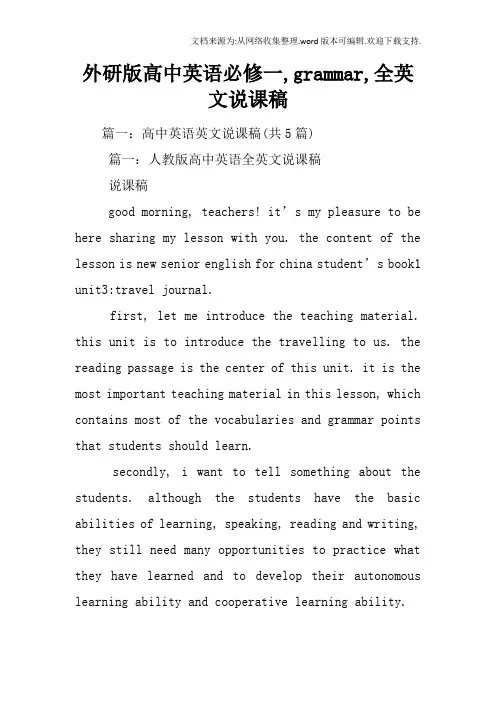
外研版高中英语必修一,grammar,全英文说课稿篇一:高中英语英文说课稿(共5篇)篇一:人教版高中英语全英文说课稿说课稿good morning, teachers! it’s my pleasure to be here sharing my lesson with you. the content of the lesson is new senior english for china student’s book1 unit3:travel journal.first, let me introduce the teaching material. this unit is to introduce the travelling to us. the reading passage is the center of this unit. it is the most important teaching material in this lesson, which contains most of the vocabularies and grammar points that students should learn.secondly, i want to tell something about the students. although the students have the basic abilities of learning, speaking, reading and writing, they still need many opportunities to practice what they have learned and to develop their autonomous learning ability and cooperative learning ability.therefore, after analyzing the teaching material and students, i put forward the teaching aims. according to the english syllabus and new lesson standard, i will talk about them from knowledge aim, ability aim and emotional aim .the knowledge aim is to hel(转载于: 小龙文档网:外研版高中英语必修一,grammar,全英文说课稿)p students understand and master the new words, phrases and sentence patterns. the ability aim is to grasp some reading ability such as guessing, skimming, scanning and so on. the emotional aim is to make students love our country and nature. fourthly, the important and difficult points.based on the requirement of the syllabus,the important point is to help students understand the whole passage and be able talk about the travel in englishthe difficult point is the new words, expressions and grammar rules. fifthly ,teaching procedure in order to realize the teaching process systematically, i divide the teaching process into six steps.step one lead- in“interest is the best teacher”, therefore, at the very beginning of the class, i should spark the students’mind to focus on the central topic”travelling” .i will show the photos of some beautiful places on powerpoint ,then ask students:do you like travel? why do you like travel? after answering the questions, the students will be eager to know something about the passage, and this is the very time to naturally lead the class into step2.step2, read for information: skimming and scanningin this step, i will use task-based language teaching method, which can give students a clear and specific purpose while skimming and scanning the passage. task one :general ideathe students will be asked to just glance at the title, and then guess what will read in the text. they’ll be divided into four groups to have a discussion.the purpose of this task is to develop students reading skill by making prediction and encouragestudents to express their thoughts in english.task two: main idea of each paragraphthe purpose of reading is to get the correct and useful information. studentsshould not only have a high speed of reading, but also have a correct understanding of details. therefore, the following practice can help check the situation. what was wang kun and wang wei’s idea of a good trip?who planned the trip to the mekong?where is the source of the mekong and which sea does it enter?step 4 solving difficult language problemsstep5 consolidationactivity one retellingi will ask four students to retell the passage.i think it’s a good way to review what they have learned.activity two role playwork in pairs. one student is wang kun and another is wang wei, choose a paragraph from the passage and use the information to make a dialogue.step6 homework1. read the passage as frequently as you can2. find out some words and sentences you think are beautiful and recite them. sixly, blackboard design 篇二:高中英语说课稿中英版ladies and gentlemen, it’s my great pleasure to be here sharing my lesson with you. the content of my lesson is ( ) book______一、教材分析analysis of the teaching material二、教学目标 teaching aims and demands三、教学重难点 teaching keys and difficulties四、教学方法 teaching methods五、教学工具 teaching aids六、教学过程 teaching procedures七、板书设计 blackboard design八、教学评价与反思now, let me talk about the teaching material first.本课时所教的是外研社高一上学期使用的必修 2 mudule6。
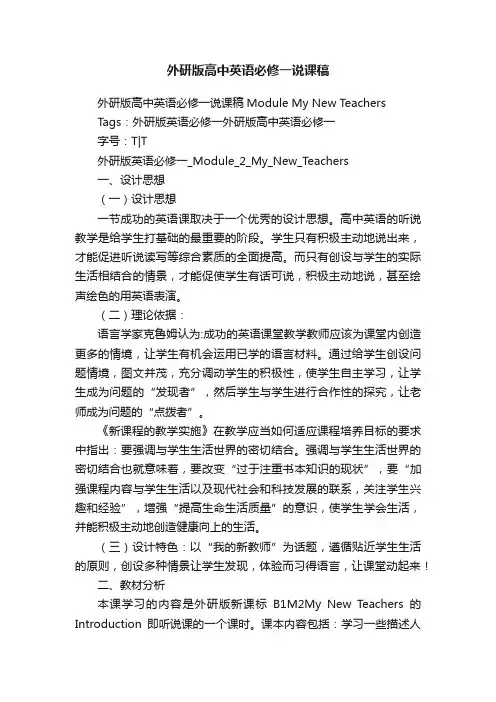
外研版高中英语必修一说课稿外研版高中英语必修一说课稿Module My New TeachersTags:外研版英语必修一外研版高中英语必修一字号:T|T外研版英语必修一_Module_2_My_New_Teachers一、设计思想(一)设计思想一节成功的英语课取决于一个优秀的设计思想。
高中英语的听说教学是给学生打基础的最重要的阶段。
学生只有积极主动地说出来,才能促进听说读写等综合素质的全面提高。
而只有创设与学生的实际生活相结合的情景,才能促使学生有话可说,积极主动地说,甚至绘声绘色的用英语表演。
(二)理论依据:语言学家克鲁姆认为:成功的英语课堂教学教师应该为课堂内创造更多的情境,让学生有机会运用已学的语言材料。
通过给学生创设问题情境,图文并茂,充分调动学生的积极性,使学生自主学习,让学生成为问题的“发现者”,然后学生与学生进行合作性的探究,让老师成为问题的“点拨者”。
《新课程的教学实施》在教学应当如何适应课程培养目标的要求中指出:要强调与学生生活世界的密切结合。
强调与学生生活世界的密切结合也就意味着,要改变“过于注重书本知识的现状”,要“加强课程内容与学生生活以及现代社会和科技发展的联系,关注学生兴趣和经验”,增强“提高生命生活质量”的意识,使学生学会生活,并能积极主动地创造健康向上的生活。
(三)设计特色:以“我的新教师”为话题,遵循贴近学生生活的原则,创设多种情景让学生发现,体验而习得语言,让课堂动起来!二、教材分析本课学习的内容是外研版新课标B1M2My New Teachers的Introduction即听说课的一个课时。
课本内容包括:学习一些描述人物的形容词;学习用这些形容词描述自己熟悉的人物;讨论并描述自己心目中的好老师;听一名英国男孩对好老师的理解并与自己的描述比较。
考虑到教学内容较少而且比较单一,不能充分调动学生的积极性,达到听说课的教学目的,我结合学生的实际生活,对教材整个模块的内容进行了整合,通过创设多种情景活动,使学生积极参与课堂活动,主动踊跃地发言,并且惟妙惟肖地表演。
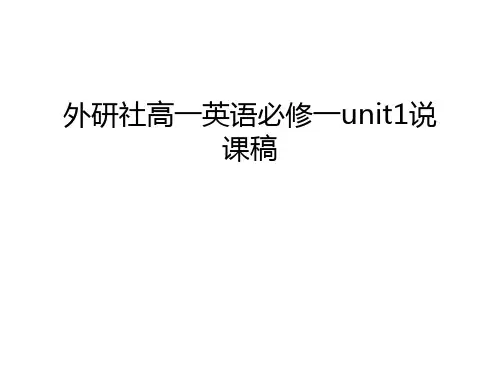
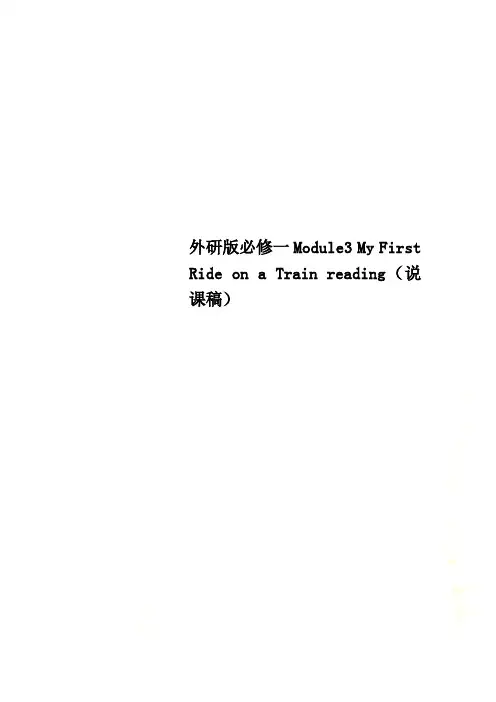
外研版必修一Module3 My First Ride on a Train reading(说课稿)My First Ride on a Train(说课稿)黑龙江省大庆实验中学Good afternoon, dear judges and teachers! My name is Jiao Xinghua, from Da Qing Shiyan High school, Heilongjiang province. I am very glad to have the chance to be here. The lesson I am going to share with you is the reading period from Module 3 Book 1, My First Ride on a Train. I am going to present the lesson from the following aspects, that is, Designing Principle, Background Analysis, Objectives, Teaching Procedures and Designing Features. I am going to explain them one by one.Part I Designing Principle:The teaching design is strictly based on English Curriculum, according to which teaching reading in senior high school has these three aims. These are the main principle of this class. Part II Background Analysis1.First I am going to talk about Learning MaterialThe text is a travel note, in which the writer tells the place he went to, the scenery he enjoyed, the things he did and the history of the train he took. There are altogether 353 words in the passage and the language is not difficult.2. Learners’ BackgroundAs senior one students, they are familiar with Chinese travel notes and have got some knowledge about Australia. However, they know little about an English travel note and know nothing about the Ghan train. In strategies, students have learned some reading strategies, such as predicting, skimming, scanning and inferring. However, they have not fully mastered them and still need more practice to train them.According to the background analysis, I set the following objectives for my class.Part III Objectives:1.By skimming and scanning, students will be able to get some factual information, such asthe writer’s personal information, what the writer saw and did during the ride and the history of the Ghan train. ( the learning focus of this period)2.By intensive reading and inferring, students will be able to grasp the writer’s feeling of theride. (the difficult point)3.By concluding, students will be able to get the structure of the text. (the difficult point)4.Students will be able to talk about their own first ride experiences.The first one is the learning focus and the second and the third one are difficult points.In order to achieve these objectives, I design the following teaching procedures.Part IV Teaching Procedures:The teaching process is divided into three parts, pre-reading, while-reading andI design a timeline to help students have a clear understanding of the famous Ghan train’shistory.After that comes the conclusion part again.And then I design an open question to encourage students’ critical thinking.1.After the detailed reading, I ask students to summarize the structure based on theconclusion they have made. I have written them on the blackboard.This activity also prepares them for the presentation of their own experience in post-reading.Then comes the Post-reading part1. Consolidation: The author writes the sentence “what a ride” in para graph 1. I let studentsa dd one adjective before the word “ride”, and give reasons. This helps students consolidate the acquired information from the text, and helps them grasp the writer’s attitude and feeling conveyed in the text. Students gave a wonderful performance. They add a lot of adjectivesaccording to the text and their own knowledge. (放视频)2. Presentation: The last activity is a presentation. Let them talk about their own first ride experience following the structure of the text.HomeworkWrite an article about your first ride on a train, a bus or a plane.Part V Designing features1. The teacher uses transition devices to facilitate students’ understanding of the text.A transition device is a way to transfer information from one form to another. Information presented in plain text form is not easy to process. When it can be transferred to another form, especially a visual form, readers can have a better understanding of the text. During students’reading process, the teacher designs some transition devices in the tasks, such as pointing out the route of the train on the map, providing pictures of the scenery and the timeline of the Ghan train’s history, all of which facilitate students’ understanding of the text.2. The teacher provides proper scaffolds in the process of leaning.According to the Background Analysis of this class, I design the tasks from easy to hard and during the learning process provides proper scaffolds in each procedure. For example, before letting students summarize the main idea of each part, I designed some factual questions so that students can catch the key words in this part, which makes the summary of the main idea more easily. Meanwhile, the summary of each part also helps students get the whole structure of the text. After knowing the structure, they can follow it to talk about their own experience. That’s the introduction of my class. Thank you for your attention.。
1.知识目标(1)To write down the sentences and passage including the new words and phrases.(2)To read the passage to train the students’ ability of intensive reading.2.能力目标1) Improve the Ss’ ability in reading.2) Train the Ss to grasp the meaning of the words from the context.3.情感目标1) Arouse the students’ love for their motherland.2) Get them to feel proud of social achievement1. How to understand the passage better.2. Master some important language points.1)recently 最近,近来2)long-distance复合词3)What引导的感叹句4)Look like5)Look out6)Get短语7)Try to do/doing8)Until用法Master the sentence structures:1. Recently, I had my first ride on a long distance train.2. We got on in Sydney and we got off in Alice Springs, night in the middle of Australia, more than...away3. We ate great meals cooked by experts!4. They didn’t need the camels any more.1. Discussion before reading to make students interested in traveling and the first ride on a train.2. Careful reading to get some detailed information.3. Explanations to the language points.1. Greet the whole class as usual.2. Divide Ss into groups and require each group to read one paragraph of the whole text.3. Meanwhile, find out the important phrases and difficult sentences.Module 3My First Ride on a TrainReading1)recently 最近,近来2)long-distance复合词3)What引导的感叹句4)Look like5)Look out6)Get短语7)Try to do/doing8)Until用法。
My First Ride on a Train(说课稿)黑龙江省大庆实验中学Good afternoon, dear judges and teachers! My name is Jiao Xinghua, from Da Qing Shiyan High school, Heilongjiang province. I am very glad to have the chance to be here. The lesson I am going to share with you is the reading period from Module 3 Book 1, My First Ride on a Train. I am going to present the lesson from the following aspects, that is, Designing Principle, Background Analysis, Objectives, Teaching Procedures and Designing Features. I am going to explain them one by one.Part I Designing Principle:The teaching design is strictly based on English Curriculum, according to which teaching reading in senior high school has these three aims. These are the main principle of this class. Part II Background Analysis1.First I am going to talk about Learning MaterialThe text is a travel note, in which the writer tells the place he went to, the scenery he enjoyed, the things he did and the history of the train he took. There are altogether 353 words in the passage and the language is not difficult.2. Learners’ BackgroundAs senior one students, they are familiar with Chinese travel notes and have got some knowledge about Australia. However, they know little about an English travel note and know nothing about the Ghan train. In strategies, students have learned some reading strategies, such as predicting, skimming, scanning and inferring. However, they have not fully mastered them and still need more practice to train them.According to the background analysis, I set the following objectives for my class.Part III Objectives:1.By skimming and scanning, students will be able to get some factual information, such asthe writer’s personal information, what the writer saw and did during the ride and the history of the Ghan train. ( the learning focus of this period)2.By intensive reading and inferring, students will be able to grasp the writer’s feeling of theride. (the difficult point)3.By concluding, students will be able to get the structure of the text. (the difficult point)4.Students will be able to talk about their own first ride experiences.The first one is the learning focus and the second and the third one are difficult points.In order to achieve these objectives, I design the following teaching procedures.Part IV Teaching Procedures:The teaching process is divided into three parts, pre-reading, while-reading and post-reading. In pre-reading, I use a free talk and prediction to lead in the topic and prepare them for the reading; in while-reading, I follow the “general-specific-general” pattern. First read the whole passage and getthe general ideas. Then, read each part in detail and get the specific information and the writer’s feeling. And at last, summarize the structure of the whole text. In post-reading, there are two activities: one is consolidation and the other is a presentation of their own experience. Now, I would explain each procedure in detail.In Pre-reading part:1. First I use a free talk to lead in the topic and activate their acquired knowledge to support the further study.2. And then let students predict which of the topics may be mentioned in the text. This will get students’ mind closer to the content of the text and make reading more purposeful.In While-reading part:1.First read the whole passage and check their predictions and at the same time they can get ageneral idea of the text.And then comes the detailed reading.2.Read paragraph 1(1). Answer the following questions: The aim is to get the background information of the ride.(放视频)When answering the third question, I let students draw the starting and ending pointon the map so that they can have a clear understanding about the route of the ride.(2). And then let students conclude the main idea of this paragraph based on these factualquestions they have answered. This activity also prepares students for concluding the structure of the whole text. After reading each part, there will be a similar task of conclusion. They all share the same purpose.3.Read paragraph 2Put the three pictures in the same order as the writer saw them and find the words to describe the pictures. This activity will help students catch the key words to describe the scenery. The three pictures here visualize what students read in the text.After answering the question comes the conclusion part again.4.Read para3Answer the two questions: The first question is to catch the key words of this paragraph. The second question is about the writer’s feeling, which is more difficult. Therefore, I guidestudents to find evidence in the text (放视频)and after they answered the questions, Iconcluded the learning tips about how to grasp the writer’s feeling in reading comprehension.After that comes the conclusion part again.5.Read para4-6I design a timeline to help students have a clear understanding of the famous Ghan train’shistory.After that comes the conclusion part again.And then I design an open question to encourage students’ critical thinking.6.After the detailed reading, I ask students to summarize the structure based on theconclusion they have made. I have written them on the blackboard.This activity also prepares them for the presentation of their own experience in post-reading. Then comes the Post-reading part1. Consolidation:The author writes the sentence “what a ride” in para graph 1. I let students add one adjective before the word “ride”, and give reasons. This helps students consolidate the acquired information from the text, and helps them grasp the writer’s attitude and feeling conveyed in the text. Students gave a wonderful performance. They add a lot of adjectives according to the text andtheir own knowledge. (放视频)2. Presentation:The last activity is a presentation. Let them talk about their own first ride experience following the structure of the text.HomeworkWrite an article about your first ride on a train, a bus or a plane.Part V Designing features1. The teacher uses transition devices to facilitate students’ understanding of the text.A transition device is a way to transfer information from one form to another. Information presented in plain text form is not easy to process. When it can be transferred to another form, especially a visual form, readers can have a better understanding of the text. During students’reading process, the teacher designs some transition devices in the tasks, such as pointing out the route of the train on the map, providing pictures of the scenery and the timeline of the Ghan train’s history, all of which facilitate students’ understanding of the text.2. The teacher provides proper scaffolds in the process of leaning.According to the Background Analysis of this class, I design the tasks from easy to hard and during the learning process provides proper scaffolds in each procedure. For example, before letting students summarize the main idea of each part, I designed some factual questions so that students can catch the key words in this part, which makes the summary of the main idea more easily. Meanwhile, the summary of each part also helps students get the whole structure of the text. After knowing the structure, they can follow it to talk about their own experience. That’s the introduction of my class. Thank you for your attention.。
Module 1 Grammar 2 Adjectives ending in –ing and –edPart 1 Teaching materialThis lesson is the Grammar part talking about adjectives ending in –ing and –ed. It plays an important role in the English teaching of this unit. By studying this lesson, students can clearly know what the differences between –ing and –ed forms and how to use them. Teacher and students will summarize and do exercises together to help students grasp the usage of “adjectives ending in –ing and –ed”.1. Teaching aims1) Knowledge objectives:a. Students are required to know the explanations of –ing form and –ed form.b. Students should find adjectives with –ing or –ed endings appeared in the text.2) Ability objectives:a. Students can translate relative sentences or phrases between English and Chinese.b. Students can learn to apply the –ing form and –ed form in their writing.2. Important points and difficult pointsIn this lesson, the important points and the difficult points are the same. That is, let the students know what the –ing form and the –ed form stand for, teach them how to use these two forms correctly and do some relative exercises to strengthen their knowledge.Part 2 Teaching methodsAs we know, the grammar is important and difficult part for students to learn English, so we should apply the proper methods to help them learn easily and quickly. According to the situation, I will apply the discussion method, the induction method and deduction method, which will help students remember the grammar rules correctly and use them properly.Part 3 Studying methods1) Doing exercise is the most common way to help students to learn grammar.2) Another way is to compare e the different usages between the –ing and –ed forms, which can help students to understand grammar and not confuse the different usage of –ing and –ed forms.Part 4 Teaching proceduresStep 3:PracticeLet the students do some relative exercises to help them understand this part of grammar.1. The situation is more ____than ever. I’m _____ about what to do next.A. puzzled; puzzledB. puzzling; puzzlingC. puzzling; puzzledD. puzzled; puzzling2. The ______ news ______ Jim. He was _____ at it.A. surprising; surprised; surprisedB. surprised; surprised; surprisingC. surprised; surprising; surprisedD. surprised; surprising; surprising3. It was so ___ a poem that quite a few students were _____ to tears.A. moved; movedB. moving; movingC. moving; movedD. moved; moving4 —How did Jack do in the exams this time?—Well, his parents seem _____ with his results.A. pleasingB. pleasureC. pleasedD. Pleasant5 They are _____ at the news that their team was beaten by ours.A. disappointingB. disappointedC. surprisingD. PleasedStep 4: Question time and homeworkI will leave 5 minutes for students to quickly review what I have taught in this lesson, and if any one has confusion about this part, he or she can ask me questions freely about that.Homework is to let students carefully review what they have learnt in class and arrange them to finish post-text exercises.Part 5: Blackboard arrangementI will divide the blackboard into three parts.Middle: write down the title “adjectives ending in –ing and –ed”.Left: the –ing form, the explanation and the relative words.Right: the –ed form, the explanation and the relative words.Module 1 Cultural Corner A Letter from a Senior High SchoolPart 1 Teaching materialThe reading passage is a letter telling about the American school system. The emphasis of this period will be placed on the important new words, expressions in the part of Vocabulary and Reading. The teacher will let students find out the differences in the American and Chinese school systems, and then ask them to give explanations about the differences. By studying this lesson, the students can improve their reading ability, comprehend the text better and master the usage of important words.1.Teaching aims1) Knowledge objectives:a. Important words and phrases:cover, divide, join in, take part in, attend.b. Important sentences: 1. At the end of twelfth grade, American studentsreceive the high school diploma. 2. I take part in all kinds ofafter-school activities.c. Grammar: Attribute clause.e.g. The school year is divided into two semesters, the first of which isSeptember through December, and the second of which is Januarythrough May.2) Ability objectives:a. Understand the main idea of the text and answer some questions.b. Talk about similarities and differences.c. Improve students’ reading ability.3) Emotion objectives:a. Let students judge the difference between China and America.b. Develop students’ sense of cooperative learning.2. Important points and difficult points1) Important points: master the new words and phrase such as cover, divide, take part in, and attend; understand the main idea of the text and answer relative questions.2) Difficult points: find out the differences in Chinese and American school systems and grasp the usage of attribute clause.Part 2 Teaching methodsFast reading, intensive reading, pair work and discussion.1). Task-Based Language TeachingThe students can get the meaning of the words and phrases. Practice can help the students get the general idea and have a better understanding of the US school system.2). Communicative ApproachDiscussion, pair work and group work can help students to express their idea bravely and clearly.Part 3 Studying methods1) Students should consider the text as a whole.2) Students should pay attention to the main ideas and topic sentences.3) Students should discuss in class to understand the passage better.Part 4 Teaching proceduresStep 1: Warming-up and lead-inWe have learned Li K ang’s school life at senior high; do you want to know the life of the teenagers in the similar age of you in other countries? Now please turn to P9, let’s read the text in cultural corner and learn something about the Senior High school life in the US.Step 2 Fast-ReadingAsk the students to read the text and answer the question on Page 9. (Fast Reading)Similarities: A school year is divided into two semesters.Differences: American schools have long vacations.Step3 Careful-ReadingAsk the students to answer the following questions. (Careful Reading)1. How long does secondary school cover in the US? (Seven years)2. Which grades is high school? (Ninth to twelfth grades)3. What do they need if they want to go to college? (A high diploma)4. How many semesters are there in the school year? (Two semesters)5. What are they? (The first of which is September through December, and thesecond January through May.).6. What is the school schedule? (They start at 7:50 am and they finish at 3 pm.)7. What is the main idea of the third and the fourth paragraph? (The studen t’safter-school activities; the author wants to know something about the Chinese school system.)Step 4 DiscussionWhat do you think of the American school system and Chinese school system?(Please express your own opinion and discuss with your partner.)Step 5 Question time and homework1. Leave 5 minutes for students to deal with their confusion.2. Let students w rite something about American or China’s school system as homework.Part 5 Blackboard arrangementModule 2 Function and SpeakingPart 1 Teaching materialThis lesson is function and speaking part. It needs students to know how to express preference through conversations. As is known to all, one of the most important ways to learn a language is communication. Thus, by studying this part, students can not only learn the patterns of expressing preference, but also improve their speaking and listening ability.1. Teaching aims1) Knowledge objectives:a. Students can use the patterns to express their preference in conversation.b. Students can improve their listening and speaking ability.2) Ability objectives:a. Train students to grasp the new expressions of preference, such as preferto…., would rather…….b. Enable students to tell others their preference.2. Important points and difficult pointsThere are two important points.1. Let the students learn to use the patterns of preference.2. How to express their preference to others.The difficult point: the students need to ask questions with new expressions and get the right answers based on the given information.Part 2 Teaching methodsI will adopt the “task-based”teaching method and “scene-activity”teaching method.1. “Task-based” teaching method can establish a real scene and the interaction between teacher and students.2. “Scene-activity”teaching method offers the students an opportunity to complete the tasks in which students use language to achieve a specific outcome. Part 3 Studying methodsSince the students are those who are in Grade One, it is important to help them form a good habit of studying.1. They should pay attention to their oral English.2. Practice makes perfect. Students should practice more so as to consolidate the usage of preference expressions.3. I should note the key points and useful expressions and encourage the students to use them after class.Part 4 Teaching proceduresStep 1: Warming-up and lead-inGreet the class and tell the students that in today’s lesson we are going to learn how to express preference.Step 2: Preparations1) Ask some questions which would enable students to get a brief sense of the situations given in the book. e.g.:a. Who is your favorite teacher? And why?b. Which of these English language areas is the most difficult for you, grammar,conversation, vocabulary, listening, reading, writing or translation?2) Provide students some useful expression of preference, such as:Prefer to do… rather than to, prefer… to…, would rather (not) do….3) Teach students how to use the useful expressions by making sentences, such as:a. I would rather drink tea than coffee.b. I would rather not go.c. She preferred to stay at home rather than go out.Step 3 PracticeFinish activity 2 and activity 3. Work in pairs, with one student asking the question and the other answering. In activity 3, the students can use some useful words and sentence patterns. For example: I would prefer to do sth rather than do sth, would rather do sth than do sth, would do sth …rather than do sth …, I enjoy/love doing sth, I like/hate doing sth, m y favorite subject is…Step 4 Question time and homeworkQuestion time: Leave 5 minutes for students to ask questions freely.Homework: Write down a composition about favorite subject and it should include the reasons for liking it.Part 5 Blackboard arrangementI will divide the blackboard into three parts.Middle: the title “Function and speaking”.Left: the expressions of preferenceRight: some examples of using these expressions.Module 3 My First Ride on a TrainPart 1 Teaching materialThis lesson is a reading passage. It plays an important role in teaching this module. It tells about the travel to the central part of Australia. By studying this lesson, students can improve their reading ability and learn more about how to describe a travel. They can understand some difficult words and sentences to comprehend the text better. The students should do some listening, speaking and writing too.1. Teaching aims1) Affection aims:a. Through reading the passage about travelling, the students can hold a feelingof loving the nature.b. Students can have courage to describe their train ride experience.c. Students can keep conscious of good co-operation2) Reading skills:a. Students are able to predict the main idea of the passage based on thebackground information and the title.b. Students are able to find the main idea of the passage by fast reading.c. Students are able to answer detailed questions (true or false questions) afterdetailed reading.3) Cultural awareness:The students can know much more about the landscape, people and customs of Australia.2. Important points and difficult points1) Important points: Train the students’ reading skills (predicting, fast reading and detailed reading); teach students how to express their travel.2) Difficult point: Teach the students to describe their first train ride focusing on who, when, where, what and how.Part 2 Teaching methodsStudents in high school are quick in thought, they are eager to show what they know and they have a certain ability to read. And the main aim is to develop the students’ capability of using English in any aspect. So I will mainly adopt “discussion”method and “task-based” method.1. Discussion method can stimulate students’ interests in reading the passage.2. Task-based method can offer the students an opportunity to complete the tasks in which students use language to achieve a specific outcome.At the same time, I will make use of the modern electricity teaching equipments and all kinds of teaching means. All these would let the students get a better understanding of the passage.Part 3 Studying methodsSince the students are those who are in Grade One, it is important to help them form a good habit of studying.1) Students should consider the text as a whole.2) Students should pay attention to the main ideas and topic sentences.3) Students should discuss in class so as to understand the passage better.Part 4 Teaching proceduresStep 1: Pre-readingGreet the class and talk about first travel.Step 2: While-reading1. Fast reading:1) Read the text quickly and find the main idea and the main idea of each paragraph.2) Discuss in pairs and match the main ideas with each paragraph.This method is to improve the students’ reading capability and generalization.2. Intensive reading:Read the text again carefully and take some notes on the textbook, then answer the questions1) Was her destination on the coast of Australia?2) Was the scenery the same during the whole journey?3) Did she study while she was on the train?4) Do they still use camels to deliver goods?Step 3: Post-reading:1) Retell the passage according to some key words.2) Share their first train ride experiences in group and some students dopresentations to the whole classStep 4: Question time and homeworkLeave 5 minutes for students to deal with their confusion.The homework is to write an article about their first train ride experiences.Part 5 Blackboard arrangementBlackboard design should be thought for a thing that attracts the students’attention. I will divide the blackboard into three parts.Middle: The title “My first ride on a train”.Left: New words and expressionsRight: Relative questions about the passage.Module 3 Reading and SpeakingPart 1 Teaching materialThis lesson is the reading and speaking part. It plays an important role in the teaching of this unit. It tells about people’s childhood memories that they did one of the activities for the first time. By studying this lesson, students can improve their reading and speaking ability, and learn more about how to express their childhood memories.1. Teaching aims1) Knowledge objectivesa. Students can improve their reading and speaking ability.b. Students can hear, read and use the main sentence patterns to express their memories, for example: I can remember my first visit /trip to…when…The first time I went to / visit …I remember the day…2) Ability objectivesa. Enable the students to describe their first experiences.b. Enable students to grasp the specific information such as when, where, how, and why.2. Important points and difficult points1. Important points:a. Get the students to learn to use the starting patterns of describing their first experiences.b. How to tell others about their first experiences.2. Difficult points:The students need to cover all the elements like who, when, where, what, why and how for the purpose of expressing their experiences clearly.Part 2 Teaching methodsStudents of this stage are quick in thought and they are eager to show what they know, and they have a certain ability to read. But they are lack of the courage to express their ideas. Therefore, in this lesson, I will use the following strategies.1) Basic learning strategy: The students can get the meaning of new words and phrases.2) Practice strategy: Practice can help the students get the general idea and havea better understanding of language; to some extent, students can develop their ability of communication, thinking and expression in English.3) Use modern electricity teaching equipments and all kinds of teaching means, it can improve the students’ creativity in learning English.Part 3 Studying methodsSince students are those who are in Grade One, it is important to help them form a good habit of studying.1) Make the students join in the reading and they are masters of the class.2) They should pay attention to their oral English.3) Require students to do listening activity, Q & A and free discussion.Part 4 Teaching proceduresStep 1 Warming-up and lead-inGreet the class and tell the students that in today’s lesson we are going to learn how to express first experiences.Step 2 Preparations1) Provide students some useful expressions:I can remember my first visit /trip to…when…The first time I went to / visit …I remember the day…2) Teach students how to describe their experiences by using these expressions.For example: elements of who, when, where, what, why and how should be included.Step 3 While-readingLet the students r ead the five people’s descriptions about their childhood memories and underline the topic sentences they use.Step 4 Practice1) Tell other students the first time you did one of the activities.2) Group work: Describe the first time you traveled a long distance to one another.Step 5 Question time and homeworkLeave 5 minutes for students to ask questions freely.The homework is to write an article about their unforgettable first experiences of doing one activity so that their writing can be improved.Part 5 Blackboard arrangementI will divide the blackboard into three parts.Middle: the title “reading and speaking”Left: some useful words and expressions.Right: some typical examples.Module 4 Listening and vocabularyPart 1 Teaching materialThis lesson is the listening and vocabulary part. It needs students to listen to two passages and answer relative questions. By studying this lesson, students can improve their listening capability, and train their skills to grasp the key points while listening. Moreover, there are some new words and phrases for students to grasp, thus their vocabulary can be enlarged through learning this lesson.1. Teaching aims1) Knowledge objectives:a. Students can improve their listening and speaking ability.b. Students can grasp new words and phrases: committee, organization, unemployed, household, occupation, professional, manual, employment, a great many things, fascinating, as a result, congratulations, to do well, make it.2) Ability objectives:a. Enable students to understand the stressed words and its meaning, as well as big numbers.b. Enable students to pronounce properly the notional words and the stressed words.3) Cultural awareness:The students can know more about our city and community.4) Affection aims:a. Through listening the passages about the community, the students can hold afeeling of loving the country and their hometown.b. Students can keep conscious of good co-operation.2. Important points and difficult points1) Important points:a. Grasp the key words and phrases.b. Improve students’ listening level2) Difficult points:How to get effective information while listening?Part 2 Teaching methods:Students of this stage are quick in thought and they are eager to show what they know, and they have a certain ability to read. And the main aim is to develop the students’ ability of grasping the effective information while listening. Therefore, I will mainly adopt “whole language teaching” method and “task-based teaching” method.1. Whole language teaching” method can help to improve students’ integrated English language competence including listening, speaking and writing.2. Task-based teaching method can offer students an opportunity to complete the tasks in which students use language to achieve a specific outcome.Part 3 Studying methods1. I will summarize the new words and phrases appearing in the listening part and introduce the key points and methods to describe a place.2. Enable students to know more about other cities and communities through learning the listening materials.3. Enable students to grasp the effective information while listening.Part 4 Teaching proceduresStep 1 Warming-up and lead-inGreet the class and write down the key words that will appear in the listening part, which will help students eliminate the vocabulary barrier.Step 2 Pre-listeningLet the students guess what the passage is about just according to those key words given on the blackboard.Step 3 While-listening1) Fill in the chart on page 35 after the first listening.2) Set students into groups to discuss the meaning and its usage of phrases and sentence patterns, then ask each group to give a dialogue by using these phrases and sentence patterns. Through this kind of practice, the usage of these patterns can be easily grasped.3) Let the students mark the stressed words, then set every two students as a pair and read out the listening part especially the stressed ones to the other.Step 4 Post-listeningDiscussion: Talk about the neighborhood committee in your area.Then ask one or two students as the representatives to talk about their neighborhood committee in class.Step 5 HomeworkMake a survey of your neighborhood committee with your partner. This way can also help students train their team spirit.Part 5 Blackboard arrangementKey words and phrases: committee, organization, unemployed, household, occupation, professional, manual, employment, a great many things, fascinating, as a result, congratulations, to do well, make it.Discussion:Talk about the neighborhood committee in your area.Module 4 Grammar 2 Present perfect tense 2Part 1 Teaching materialThis lesson is the grammar part, and it is about the present perfect tense. By studying this lesson, the students can know better about the present perfect tense and use it correctly. Moreover, learning this part well would improve students’reading and writing ability. Teacher and students will summary and do exercises together to help students grasp the usage of present perfect tense.1. Teaching aims1) Knowledge objectivesa. Review the past simple tense and the present perfect tense.b. Grasp important phrases and sentence patterns:so far, up to now, till now, all one’s lifeI’ve worked for it for four years now.I’ve known him since September.It’s been very successful, so far.Up to now, I’ve understood everything the teacher’s said.We’ve had very good weather this winter, t ill now.2) Ability objectivesa. The students will be able to learn more about the Present Perfect Tense.b. The students can know how to use present perfect tense.2. Important points and difficult points1) Important points:a. Grasp the present perfect tense.b. To enable students to strengthen their grammar language knowledge which would help them to improve their ability of listening, reading and writing by doing some relative exercises.2) Difficult points:Present perfect tense with verbs is to describe events that can continue over a period of time, and it is easily mixed with the simple past tense which describes events happened at a particular point in time. So how to correctly use present perfect tense will be the difficult part.Part 2 Teaching methodsAs we know, grammar is an important but difficult part in learning English, so we should apply proper methods to help them learn easily and quickly. According to the situation, I will apply “deduction”method and “induction”method. These two methods would also help to improve students’ ability of self-learning.Moreover, I’d like to apply “task-based”method which offers students an opportunity to complete the tasks when they use language to achieve a specific outcome.Part 3 Studying methods1) As for learning grammar, doing exercise is the most common way to help students to learn.2) Another way is comparison which can help students to understand grammarand figure out the usage of present perfect tense.Part 4 Teaching proceduresStep 1 Greeting and lead-inGreet the class as usual and help students revise the use of present perfect tense.Step 2 The usage of present perfect tense:1. Present perfect tense is used for completed past actions or events, and it is the present result of the events that is significant. It is usually used together with just, recently, so far, up to now, till now, in the past, ever and never, etc.1)They have put up a lot of high-rise buildings recently.2)My wife has just bought a beautiful dress from one of the shops there.3)I've seen quite a lot of China.4)It has been six years since we last saw each other.2. Present perfect tense can also be used for ongoing or habitual situations continuing up to the present time (and not necessarily completed), particularly in describing for how long or since when something has been the case.And it usually used together with since, these days, this year, now, etc.1)She has lived in Beijing since she came to China.2)They have been friends for forty years.3)How many words have you learned this year?Step 3 PracticeLet the students do the exercises on page 36.Step 4 Question time and homeworkIf any student has confusion about this part, he or she can ask questions freely.The homework is to ask students to review what they have learnt in today’s lesson and finish the rest of the post-text exercises.Part 5 Blackboard arrangementBlackboard design should be thought for a thing that attracts students’ attention.I will divide the blackboard into three parts.Middle: Title “present perfect tense”.Left: The first situation of the usage of present perfect tense as well as its related words and phrases.Right: the second situation of the usage of present perfect tense as well as its related words and phrases.Module 5 Cultural CornerPart 1 Teaching materialThis lesson is cultural corner part. It is Mark Kendon’s description of science teaching in his school. By studying this lesson, students can have knowledge of the situation of learning science in foreign countries. Moreover, students can improve their reading ability and enlarge their vocabulary.1. Teaching aims:1) Knowledge objectivesa. Learn and grasp the following important useful new words and expressions in the part:lecture,astonished,used to do,be supposed to do and so on.b. Understand a passage about science teaching in Canada.2) Ability objectivesa. Improve the ability in reading.b. Grasp the meaning of the words from the context.3) Emotion aimsa. To raise students' interests in science and form the rigorous scientific attitude.b. Arouse their interest of learning so that they can form their own goals of study.c. To make them understand the importance of scientific knowledge.2. Important points and difficult pointsa. To make the students understand and grasp the vocabulary and knowledge related to science and experimentsb. To enable the students to grasp the effective information of the text.Part 2 Teaching methodsStudents of this stage are quick in thought and they are eager to show what they know, and they have a certain ability to read. And the main aim is to develop the students’ability of using English in any aspect. Therefore, in this lesson, I will mainly use “discussion” method and “task-based” method.Discussion method can stimulate students’ interests in reading the text.Task-based method can offer students the opportunity to complete the tasks in which students use language to achieve a specific outcome.At the same time, I will make use of the modern electricity teaching equipments and all kinds teaching means. All of these would let the students get a better understanding of the text.Part 3 Studying methodsSince the students are those who are in Grade One, it is important to help them form a good habit of studying. In class, I will try my best to help them form a good habit of studying English.1. They should consider the text as a whole.2. They should pay attention to the main idea and the topic sentences.3. I should note the key points and useful expressions.Part 4 Teaching proceduresStep 1 Greeting and lead-in。
高一英语外研版必修book1and book2 说课稿
B1 M1 My first day at senior high
一教材内容
本模块介绍一位高中新生第一天到校观察和接触到的人和事物,以及个人感受,内容紧密结合学生的现实生活,通过此部分的学习,使学生们通过课本所描述的生活对比感知自己高一第一天的生活,激发学习兴趣。
二学生分析
学生刚进入高一学习,还不适应新的老师新的环境新的教学方法,更不适应高中全英语教学,很多学生存在胆怯害羞不敢开口的情况,所以老师上课时要通过问候,师生自我介绍等方式消除学生的害怕心理。
三教学重点难点
1掌握重点词汇|、词组、及句型结构
2比较一般现在时与现在进行时的用法
3描述学校的情况
四教学方法
任务型教学法、情景教学法、交际教学法、启发式教学法
五教学手段:多媒体教学
六教学步骤
Period 1 Introduction +listening +vocabulary
Pictures –words---listen1----listen2---act out
更新时间:2012-05-19 20:36:00
说课稿
各位老师大家好,今天我说课的内容为外研社普通高中课程标准实验教学用书必修1,module3 My first ride on a train。
我上的是一堂听说课。
一教材分析::
1.新教材特点介绍:
高中必修阶段教材模块内容分为,Introduction, Reading and Vocabulary, Listening, Speaking, Writing, Grammar, Function, Everyday English, Pronunciation, Culture Corner, Task and Module File, 听说读写,词汇,语法等基本成对出线,各项技能均为综合性训练,注重语境化和语用化。
从模块内容上看,第一增加了Function, Everyday English 和 Pronunciation,这三部分是与模块听力或阅读材料有关的常见和典型的英语习惯用语。
可见本套教材更加注重在特定语境中的口语练习,而且难度相对不高。
第二增加了单元任务,更加强调任务教学。
从模块内容分布上来看,与人教版教材的最大区别是将阅读部分提前到技能和语言项目学习的前面,即热身之后就开展阅读。
而且值得注意的还有阅读篇幅明显缩短,文章难度明显下降。
本套教材以阅读为中心向其他语言技能扩散,所有单元涉及的语言技能都与阅读密不可分。
我认为本教材之所以这样编排是因为在听、说、读、写这四个环节中,学生对于读的技巧掌握最好,所以通过在热身之后就开展阅读,可以让学生对单......
外研版高中英语必修1说课稿 module3 My first ride on a train。